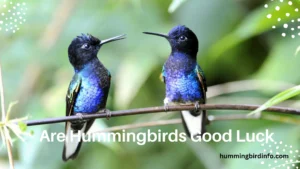The hummingbird, with its dazzling feathers and rapid wings, has captured the hearts of people around the world. Though it’s one of the smallest birds, it leaves a large impact—both in the natural world and in the hearts of those who spot one.
Whether hovering mid-air or darting between flowers, it feels almost magical.
Many believe that spotting a hummingbird is more than a simple encounter—it’s a sign from the universe. In countless cultures, these birds are seen as symbols of good luck, love, and resilience.
Their sudden appearances often bring smiles, spark memories, and even offer comfort during tough times.
So why do hummingbirds feel so special? This blog will explore the spiritual, cultural, and symbolic meanings behind hummingbirds. From ancient beliefs to modern interpretations, we’ll uncover why these tiny wonders are often linked to good fortune and joy.
Contents
- 1 1. General Symbolism of Hummingbirds
- 2 2. Cultural Interpretations of Hummingbirds
- 3 3. Spiritual Meanings of Hummingbirds
- 4 4. The Connection to Good Luck
- 5 5. Hummingbirds in Art, Folklore, and Science
- 6 Conclusion
- 7 FAQ’s
- 7.1 1. Do hummingbirds bring good luck?
- 7.2 2. What does it mean when a hummingbird visits you?
- 7.3 3. Are hummingbirds considered spiritual animals?
- 7.4 4. Is it true that Native Americans see hummingbirds as lucky?
- 7.5 5. Can seeing a hummingbird mean love is coming?
- 7.6 6. Are hummingbirds associated with death or spirits?
1. General Symbolism of Hummingbirds
Hummingbirds are symbols of joy and happiness, thanks to their bright colors and cheerful presence. Their light-hearted flight and attraction to beautiful flowers remind us to find pleasure in small things. These tiny birds uplift moods and spark a sense of wonder.
With their high metabolism and constant motion, hummingbirds also represent energy and vitality. They flap their wings up to 80 times per second, making them one of the most active birds. This liveliness symbolizes a full embrace of life and a thirst for experience.
Hummingbirds are admired for their resilience and adaptability, thriving in diverse climates. They migrate long distances—some travel over 2,000 miles—showing strength far beyond their size. These qualities inspire people to remain strong and flexible during hard times.
Their unique ability to fly backward, forward, or hover makes them a symbol of freedom and flexibility. These traits reflect the importance of going with the flow and embracing change. Hummingbirds remind us not to be afraid of new directions.
Lastly, their role in pollination links them with love and beauty. As they feed, they help flowers grow, symbolizing harmony and connection. Their presence in blooming gardens is often seen as a sign of peace and spiritual alignment.

2. Cultural Interpretations of Hummingbirds
In Native American cultures, hummingbirds are revered as messengers of love and joy. Some tribes believe they carry messages from loved ones who have passed away. Others see them as symbols of healing and perseverance.
Tribes like the Hopi and Zuni link hummingbirds to rain and fertility, associating them with good harvests. Legends tell of hummingbirds pleading with the gods for rain, making them messengers of life and renewal. Their delicate presence holds deep meaning.
In Aztec culture, warriors who died in battle were believed to return as hummingbirds. The bird symbolized vitality, courage, and transformation. Similarly, the Inca saw hummingbirds as messengers of the gods, linking them to the divine realm.
In Central and South America, hummingbirds are often tied to the life force. Their rapid movement and connection to nectar symbolize the sweetness and intensity of life. In many places, they are celebrated in festivals and spiritual ceremonies.
Around the world, hummingbirds are depicted in folklore, carvings, jewelry, and textiles. From Caribbean beliefs to Hawaiian stories, these birds are seen as protectors, guides, or bringers of luck and beauty wherever they appear.
3. Spiritual Meanings of Hummingbirds
Spiritually, hummingbirds are believed to be messengers from the divine. Their sudden appearance is often taken as a sign of encouragement, love, or reassurance from a higher realm or departed loved ones. Many people find peace in such encounters.
Their constant movement symbolizes the importance of living in the moment. Unlike birds that soar in long, lazy flights, hummingbirds stay focused on the now. They remind us to appreciate our daily joys, blessings, and presence.
The hummingbird’s tiny size hides a spirit of immense strength and resilience. They undertake long migrations despite their delicate frame. This mirrors our inner strength and reminds us that power isn’t always visible.
Hummingbirds also represent healing and transformation. Their presence can feel soothing during emotional or physical pain. In spiritual teachings, they signal a time of renewal, hope, and positive change.
Many believe that if a hummingbird appears in your life, it’s a spiritual nudge to stay optimistic, keep moving forward, and remain open to life’s beauty. They’re tiny symbols of big messages.
4. The Connection to Good Luck
The idea that hummingbirds bring good luck likely comes from their positive symbolism and surprising visits. Cultures that saw them as sacred or divine naturally passed down these beliefs. Over time, the bird became a symbol of fortune and protection.
People often interpret a hummingbird sighting as a sign of good news or coming blessings. Their appearance might signal the end of hardship, or the start of something wonderful. Some believe they show up just when they are most needed.
Others say hummingbirds represent fulfilled dreams or the presence of a guardian spirit. Spotting one after making a wish or during an emotional moment can feel like a meaningful sign. They bring a sense of being seen or watched over.
Believing that hummingbirds bring good luck is also a form of personal spirituality or superstition. While not backed by science, such beliefs offer comfort, joy, and connection to something greater. Faith in luck itself can be powerful.
In gardens, at windows, or during walks, many feel that a hummingbird’s presence is a message of hope. It’s a reminder that even small things can carry deep meaning and that goodness often comes in surprising forms.

5. Hummingbirds in Art, Folklore, and Science
Throughout art and history, hummingbirds have been a source of inspiration. Their form appears in jewelry, tattoos, pottery, and paintings. These images often symbolize delicate strength, love, and vibrant life.
In folklore, hummingbirds appear as heroes, travelers, and symbols of devotion. A Mayan story tells of a hummingbird created from leftover feathers, yet it became one of the most beautiful and admired. Their tales often share themes of wonder and magic.
Scientifically, hummingbirds make people feel happy and amazed. Their beauty, hovering flight, and iridescent colors create a sense of awe and positivity. Even a brief sighting can lift a person’s mood or create a lasting memory.
Hummingbird encounters help people feel closer to nature, which has proven mental health benefits. They spark feelings of joy, relaxation, and curiosity. For many, this alone makes them a symbol of healing and good fortune.
Some believe in the placebo effect—believing a hummingbird brings good luck can cause a person to feel more confident and hopeful. Whether symbolic or scientific, their impact is real and deeply personal.
Conclusion
Hummingbirds are more than just tiny birds—they’re symbols of joy, energy, and emotional strength. From their spiritual meanings to their vibrant presence in art and culture, they’ve always carried messages of hope and wonder.
Across continents and generations, these birds have been seen as divine messengers, protectors, and bearers of good luck. Their power lies in their ability to evoke emotion, spark awe, and offer comfort in life’s uncertain moments.
Their appeal endures because they represent what we all long for—beauty, resilience, love, and peace. The next time you see a hummingbird, take it as a reminder that even small things can carry great meaning.
Whether or not you believe in good luck, there’s something magical about hummingbirds. They bring us back to nature, to wonder, and to the joy of being alive. And sometimes, that alone is all the luck we need.
FAQ’s
1. Do hummingbirds bring good luck?
Yes, in many cultures, hummingbirds are seen as symbols of good luck, joy, and hope. Their sudden appearance is often interpreted as a positive sign.
2. What does it mean when a hummingbird visits you?
Many believe a visit from a hummingbird means positive change is coming or that a loved one is watching over you. It’s seen as a message of encouragement.
3. Are hummingbirds considered spiritual animals?
Yes, hummingbirds are often viewed as spirit guides or messengers, associated with divine energy, healing, and love.
4. Is it true that Native Americans see hummingbirds as lucky?
Yes, several Native American tribes see hummingbirds as symbols of love, peace, and good fortune. Some even believe they carry messages from the spirit world.
5. Can seeing a hummingbird mean love is coming?
In many traditions, a hummingbird is a symbol of romance and harmony, so seeing one may be taken as a sign of love entering your life.
6. Are hummingbirds associated with death or spirits?
Yes, in some cultures, they are thought to be visitors from the spirit world or signs from deceased loved ones, bringing peace or closure.








